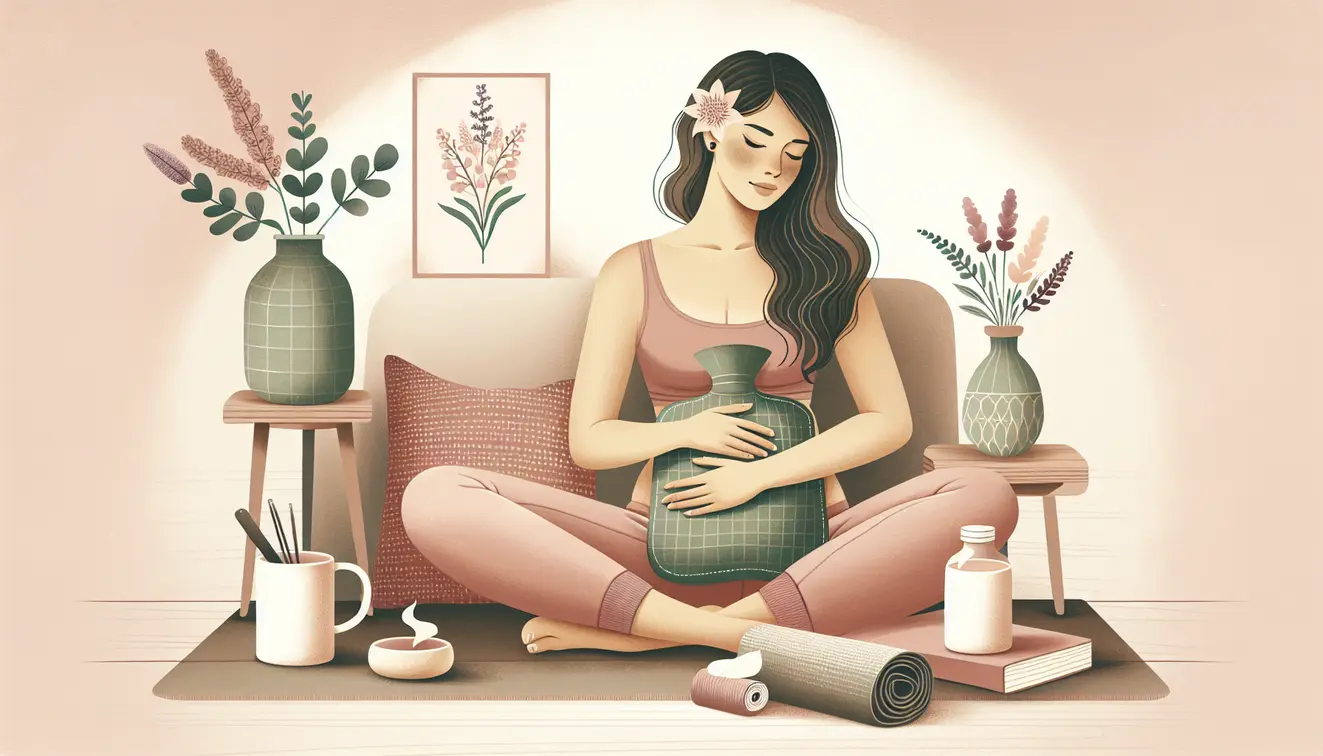Home Remedies for Period Cramps: Your 2025 Guide to Natural Relief
Estimated reading time: 10 minutes
Key Takeaways
- Period cramps are common, affecting up to 90% of menstruating individuals, and can be eased with natural solutions.
- Home remedies like heat therapy, hydration, and herbal teas offer safe, accessible relief with fewer side effects.
- Understanding triggers such as stress or dehydration can help tailor effective, personalized approaches.
- Long-term lifestyle changes, including diet and exercise, may reduce the severity of cramps over time.
- Always prioritize safety by testing remedies and consulting professionals for severe or persistent pain.
Table of Contents
- Introduction to Period Cramps and Natural Solutions
- What Causes Period Cramps? Unveiling the Science
- Why Opt for Home Remedies? Benefits and Considerations
- Top 10 Evidence-Backed Home Remedies for Period Cramps
- Safety Tips When Using Home Remedies
- Long-Term Lifestyle Changes for Cramp Prevention
- Frequently Asked Questions (FAQs) for Clarity
- Additional Resources for Menstrual Health Support
1. Introduction to Period Cramps and Natural Solutions
Period cramps, also known as dysmenorrhea, affect countless individuals every month, bringing discomfort that can disrupt daily life. For many, the sharp pain in the lower abdomen serves as a reminder of the body’s natural cycle, yet it often feels overwhelming. At WikiHomeRemedies, we understand this struggle and believe nature offers gentle, effective ways to ease the burden.
Statistics from the American College of Obstetricians and Gynecologists (ACOG) suggest that up to 90% of menstruating individuals experience some level of pain during their cycle. While over-the-counter medications are common, a growing number prefer home remedies—solutions that are often more affordable and come with fewer side effects. This guide is here to walk you through safe, research-backed options for relief in 2025.
Our goal is simple: provide you with practical ideas to soothe cramps naturally. Whether you’ve tried everything or are just starting to explore holistic paths, we’re here to help with empathy and clarity. Let’s begin by understanding what’s behind this pain.
2. What Causes Period Cramps? Unveiling the Science
To find relief, it helps to know why period cramps happen in the first place. During menstruation, the uterus contracts to shed its lining, a process driven by chemicals called prostaglandins. These substances trigger inflammation and pain, often felt as a dull ache or sharp twinges in the lower belly.
Higher levels of prostaglandins can make the discomfort more intense, as noted by research from the National Institutes of Health (NIH). These contractions reduce blood flow to the uterus, adding to the strain. While this is a normal part of the cycle for most, certain factors can worsen the experience.
Some common triggers include:
- High stress, which tightens muscles and amplifies pain.
- Diets heavy in salt or caffeine, leading to bloating.
- Dehydration, which can heighten muscle tension.
- Health conditions like endometriosis or uterine fibroids, which may cause severe symptoms.
If your pain feels unbearable or your cycle becomes irregular, it’s wise to speak with a healthcare provider. Understanding these root causes equips us to tackle the discomfort with targeted natural solutions.
2.1. Physiological Factors Behind the Pain
Let’s dive a bit deeper into the body’s role in this process. When the uterine muscles contract to expel the lining, prostaglandins play a key part, often determining how much pain you feel. Studies from the Mayo Clinic show that those with elevated prostaglandin levels report stronger cramps, as these chemicals heighten inflammation.
Reduced oxygen to the uterine tissue during contractions also contributes to that throbbing sensation. It’s a natural mechanism, but for some, it becomes a monthly hurdle. Knowing this helps us choose remedies that relax muscles or curb inflammation effectively.
2.2. Lifestyle and Health Triggers
Beyond the body’s internal process, everyday habits can play a role in cramp severity. Stress, for instance, releases hormones like cortisol that tighten muscles and worsen pain, as WebMD points out. A lack of movement or poor hydration often adds to the tension, making the body less resilient.
Certain foods or drinks, such as caffeine, can increase bloating and discomfort. Underlying issues like endometriosis may also amplify symptoms dramatically. Recognizing these triggers offers a starting point for small changes that bring lasting ease. For related discomforts in the abdominal area, explore additional natural solutions at WikiHomeRemedies – Bloating and Gas Remedies.
3. Why Opt for Home Remedies? Benefits and Considerations
Turning to home remedies for period cramps makes sense for many. These approaches often use ingredients or methods already within reach, saving both money and trips to the pharmacy. More importantly, they align with a desire for holistic care that works with the body rather than against it.
Consider some of the perks:
- They typically carry fewer risks of side effects compared to medications.
- Many empower you to take control of your wellness routine.
- They often complement lifestyle habits for broader health gains.
That said, results can differ from person to person. What soothes one might not work for another, and severe cases may still need medical support. As the Cleveland Clinic often highlights, natural options shine as a first step or supplement to professional care. With this in mind, let’s explore specific ways to find relief.
4. Top 10 Evidence-Backed Home Remedies for Period Cramps
Now, let’s get to the heart of easing your discomfort with practical, researched solutions. These ten remedies draw from both science and time-tested traditions, offering a range of options to suit your needs. Each comes with clear steps and precautions to ensure you apply them safely.
4.1. Heat Therapy for Muscle Relaxation
Heat can work wonders for period cramps by loosening tight uterine muscles and improving blood flow. The Mayo Clinic often recommends this method as a go-to for immediate relief. It’s a simple, soothing option many find helpful.
To try it:
- Place a heating pad or hot water bottle on your lower abdomen for 15-20 minutes.
- Ensure the temperature is comfortable to avoid burns.
- Repeat as needed during peak pain.
This mimics the body’s natural need for warmth and relaxation during stress. Just be mindful not to overheat or leave it on too long.
4.2. Hydration to Ease Bloating and Tension
Staying hydrated seems basic, but it plays a big role in reducing bloating and muscle strain during your period. Dehydration can worsen cramps, as the NIH notes, by increasing tension in the body. Water helps flush out excess sodium that contributes to discomfort.
Consider these tips:
- Drink at least 8-10 glasses (about 2-2.5 liters) of water daily.
- Sip on herbal teas or infused water if plain feels dull.
- Avoid sugary or caffeinated drinks that dehydrate.
Small sips throughout the day keep you balanced. It’s an easy habit with a noticeable impact. For more tips on managing bloating, check out WikiHomeRemedies – Remedies for Bloatedness.
4.3. Herbal Teas: Chamomile, Ginger, and Peppermint
Herbal teas offer a warm, comforting way to tackle cramps with anti-inflammatory benefits. Ginger, for instance, has shown pain-relieving effects in studies by the National Center for Complementary and Integrative Health (NCCIH). Chamomile and peppermint also calm muscles and ease stress.
Here’s how to prepare:
- Steep 1-2 teaspoons of dried herbs or a tea bag in hot water for 5-10 minutes.
- Drink 1-2 cups daily during your period.
- Avoid overdoing ginger if you have a sensitive stomach.
Sip slowly and let the warmth settle in. It’s like a gentle hug for your insides.
4.4. Dietary Adjustments for Pain Reduction
What you eat during your cycle can shift how cramps feel. Foods rich in magnesium, like leafy greens or nuts, relax muscles, as supported by NIH research. Omega-3s from fish or flaxseed also fight inflammation that fuels pain.
Try these shifts:
- Add spinach, almonds, or salmon to meals.
- Cut back on salty snacks and caffeine to reduce bloating.
- Focus on small, frequent meals to avoid strain.
These choices support your body’s natural rhythm. Over time, they build a foundation for less pain.
4.5. Gentle Exercise and Yoga Poses
Movement might feel like the last thing you want, but gentle exercise boosts endorphins—your body’s pain fighters. Harvard Health points to light activity as a proven way to lessen menstrual discomfort. Yoga, in particular, stretches tight muscles and calms the mind.
Give these a go:
- Try child’s pose or cat-cow stretch for 5-10 minutes.
- Walk slowly for 15-20 minutes if yoga isn’t your style.
- Stop if anything feels worse.
Even a short session can lift your mood. It’s about easing in, not pushing hard.
4.6. Essential Oils: Lavender and Clary Sage
Essential oils like lavender and clary sage bring a calming touch to period pain through massage or diffusion. Emerging research on PubMed suggests lavender reduces stress, which can lower pain perception. Clary sage may directly target muscle spasms.
Use them safely:
- Dilute 2-3 drops in a carrier oil like coconut before rubbing on your abdomen.
- Avoid direct skin contact without dilution to prevent irritation.
- Inhale through a diffuser for a subtler effect.
This remedy pairs scent with relief. Test a small area first to rule out reactions.
4.7. Magnesium: Supplements and Epsom Salt Baths
Magnesium stands out for its ability to relax muscles and curb cramps, as WebMD confirms. Whether through supplements or a warm Epsom salt bath, it helps ease uterine tension. It’s a mineral your body often craves during this time.
Here’s how:
- Soak in a tub with 1-2 cups of Epsom salt for 15-20 minutes.
- Or take a 200-400 mg supplement after consulting a doctor.
- Don’t overdo supplements to avoid digestive upset.
A bath doubles as relaxation. It’s a quiet way to recharge and relieve.
4.8. Acupressure and Massage Techniques
Acupressure targets specific points to release tension, a practice backed by the NCCIH for complementary pain relief. Massaging the LI4 point—between thumb and index finger—or your lower abdomen can dull cramps. It’s a hands-on fix you control.
Try this:
- Press the LI4 point firmly for 1-2 minutes while breathing deeply.
- Rub your lower belly in slow circles with light pressure.
- Stop if it feels uncomfortable.
This taps into the body’s energy flow. A few minutes can shift how you feel.
4.9. Rest and Stress Management Practices
Never underestimate rest when cramps strike. Stress heightens pain perception, as the Cleveland Clinic explains, while sleep and relaxation reset your system. Taking time to unwind isn’t just comfort—it’s strategy.
Consider these:
- Lie down for 20-30 minutes with a pillow under your knees.
- Practice deep breathing or a short guided meditation.
- Limit screen time before bed to improve rest.
Slowing down helps your body heal. It’s a reminder to prioritize yourself.
4.10. Hot Compress with Herbal Infusions
Combining heat with herbs like rosemary or chamomile in a compress adds an extra layer of relief. Traditional practices often pair warmth with herbal properties for deeper muscle relaxation. It builds on basic heat therapy with a natural twist.
Make your own:
- Soak a cloth in warm water infused with dried herbs for 5 minutes.
- Wring it out and place it on your abdomen for 10-15 minutes.
- Keep the temperature moderate to protect skin.
This feels like a crafted remedy from nature. Reapply as needed for ongoing comfort.
5. Safety Tips When Using Home Remedies
While natural remedies bring hope, they require care to avoid unintended hiccups. Everyone’s body reacts differently, so what helps one might not suit another. At WikiHomeRemedies, we want your journey to relief to stay safe and sensible.
Watch for a few things:
- Test essential oils or herbs on a small skin patch first to spot allergies.
- Don’t overuse supplements or teas—stick to recommended amounts.
- Stop any remedy if symptoms worsen or new issues arise.
If you have existing health conditions, a quick chat with a healthcare provider adds peace of mind. The Mayo Clinic and WHO stress consulting professionals for persistent or severe pain. Trust your instincts and pair these solutions with caution for the best outcome.
6. Long-Term Lifestyle Changes for Cramp Prevention
Beyond quick fixes, building habits can lessen period cramps before they start. Small, steady adjustments to how you live support your body month after month. Let’s look at ways to make pain less of a regular visitor.
Focus on sustainable steps like consistent movement, mindful eating, and stress balance. These aren’t overnight cures but investments in your well-being. Harvard Health backs this approach, showing lifestyle shifts impact menstrual health over time.
6.1. Building a Consistent Exercise Routine
Regular activity balances hormones and eases muscle tension, reducing cramp intensity. The NIH notes that even moderate exercise lowers pain levels in the long run. It’s less about intensity and more about consistency.
Start with:
- 20-30 minutes of walking or light stretching most days.
- Mix in yoga or swimming for variety and low impact.
- Set a schedule that fits your life to stick with it.
Your body adapts with time. Each step forward builds resilience against discomfort.
6.2. Adopting a Cramp-Friendly Diet
Eating with intention prevents inflammation and supports muscle health. WebMD suggests focusing on anti-inflammatory foods like berries or whole grains daily, not just during your period. Hydration remains key year-round.
Incorporate these:
- Snack on nuts or seeds for magnesium and healthy fats.
- Swap processed foods for fresh vegetables and fruits.
- Keep water handy to avoid bloating triggers.
This becomes second nature with practice. It’s fuel for a smoother cycle.
6.3. Ongoing Stress Reduction Techniques
Keeping stress in check prevents the body from amplifying pain. The Cleveland Clinic ties mental calm to physical ease, especially for menstrual health. Finding what relaxes you matters as much as any remedy.
Explore options:
- Set aside 10 minutes daily for mindfulness or journaling.
- Engage in hobbies that lift your spirits consistently.
- Consider therapy if stress feels heavy over time.
These habits ground you. They’re tools to carry through each month with confidence.
7. Frequently Asked Questions (FAQs) for Clarity
We know you might have lingering thoughts about easing period cramps naturally. Here, we address common queries to guide you further. Let’s clear up any doubts with straightforward answers.
- How quickly do home remedies work for period cramps? Most, like heat or hydration, can bring relief within 15-30 minutes. Herbal teas or dietary shifts may take a cycle or two for full effect.
- Can home remedies replace pain medication entirely? For mild to moderate pain, they often suffice, but severe cases might still need meds. Consult a doctor if discomfort persists.
- Are specific remedies better for severe cramps or endometriosis? Heat and magnesium show promise for intense pain, per Mayo Clinic insights. Tailor choices to your symptoms and seek medical advice for conditions like endometriosis.
- What if a remedy worsens my symptoms? Stop immediately and try something else. Listen to your body and note reactions for future reference.
- How can I track which remedies work best for me? Keep a simple journal of what you try and how you feel. Patterns emerge over a few cycles.
These answers build on trusted health guidance. They’re here to help you navigate with ease.
8. Additional Resources for Menstrual Health Support
Your path to managing period cramps doesn’t end here. Plenty of credible sources and communities offer deeper insights and support. We’ve gathered a few to keep you informed and connected.
Consider these:
- Visit the World Health Organization (WHO) or National Institutes of Health (NIH) websites for menstrual health research.
- Explore Mayo Clinic’s online portal for practical pain management tips.
- Join safe online forums like those hosted by WebMD for shared experiences.
We also suggest creating a tracker to log remedies and their effects. A downloadable checklist from WikiHomeRemedies can help organize this. These tools and resources empower you to take the next step in your wellness journey. For related women’s health concerns, such as yeast infections, you can find additional natural remedies at WikiHomeRemedies – Yeast Infection Remedies.










